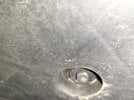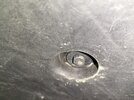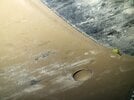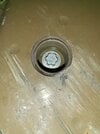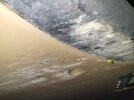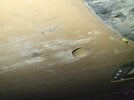tesla theory of operation of air suspension on model s and x 2019 and newer
Chassis height front - unladen (measured at the HV battery) 173.5 ± 5 mm
Chassis height rear - unladen (measured at the HV battery) 177.6 ± 5 mm
Chassis height front - unladen (measured at suspension bolt) 259 mm
Chassis height rear - unladen (measured at suspension bolt) 192 mm
Leveling rate between 1 mm/s and 10 mm/s
Reservoir fill capacity > 3 bar/minute
Minimum average wheel height (in normal system operation) -40 mm
Maximum average wheel height (in normal system operation) 41 mm
Leveling hysteresis ±5 mm of target level
Maximum system pressure (seen at the reservoir) 18 bar
Minimum system pressure (set by internal check valve of the compressor) 3.6 bar
Calibrate Air Suspension
During the the ride height calibration process, a correction value (offset) for each of the four sensors is calculated and stored permanently in the ECU’s EEPROM (Electrically Erasable Programmable Read Only Memory). A "perfect" vehicle that matches CAD exactly would have calibration offsets of 0. In reality each corner may need a small offset to match the ride height sensor values with the actual vehicle ride height.
Performing a ride height calibration is required when removing or replacing height sensors, after changing the TAS2 ECU, when performing repairs on the suspension or before a wheel alignment.
Ride height calibration of the vehicle height must be performed at STANDARD ride height on a 4-wheel alignment lift (see the Service Manual for more information). During ride height calibration, Toolbox asks the technician to confirm the wheel type and check the tire pressures. Always refer to the Service Manual for the latest information on ride height; General Information > Technical Data > Wheel alignment > Suspension Bolt Height.
Once wheel type and tire pressures are confirmed, vehicle will level to high ride height and then lowered to standard ride height. By doing this the vehicle will try to level all 4 corners to 0 ± 5 mm (standard).
Physically measure the actual ride height between the ground (4-post lift) and the bottom of the chassis at pre-selected points. These heights should be entered in Toolbox. These values should not differ much from the ride height specification. The ride height for Palladium X is 259 mm for the front suspension and 192 mm for the rear suspension
Toolbox sends the 4 measured ride height values to the vehicle. The vehicle will calculate an offset value for each of the corners. These offsets are used to match the measured ride heights with the ride height sensor values. This process is called 'ride height calibration'.
Example: Vehicle levels from STANDARD to HIGH and back to STANDARD. It ends at the following ride heights (all nicely within the ±5 mm window):
Chassis height front - unladen (measured at the HV battery) 173.5 ± 5 mm
Chassis height rear - unladen (measured at the HV battery) 177.6 ± 5 mm
Chassis height front - unladen (measured at suspension bolt) 259 mm
Chassis height rear - unladen (measured at suspension bolt) 192 mm
Leveling rate between 1 mm/s and 10 mm/s
Reservoir fill capacity > 3 bar/minute
Minimum average wheel height (in normal system operation) -40 mm
Maximum average wheel height (in normal system operation) 41 mm
Leveling hysteresis ±5 mm of target level
Maximum system pressure (seen at the reservoir) 18 bar
Minimum system pressure (set by internal check valve of the compressor) 3.6 bar
Calibrate Air Suspension
During the the ride height calibration process, a correction value (offset) for each of the four sensors is calculated and stored permanently in the ECU’s EEPROM (Electrically Erasable Programmable Read Only Memory). A "perfect" vehicle that matches CAD exactly would have calibration offsets of 0. In reality each corner may need a small offset to match the ride height sensor values with the actual vehicle ride height.
Performing a ride height calibration is required when removing or replacing height sensors, after changing the TAS2 ECU, when performing repairs on the suspension or before a wheel alignment.
Ride height calibration of the vehicle height must be performed at STANDARD ride height on a 4-wheel alignment lift (see the Service Manual for more information). During ride height calibration, Toolbox asks the technician to confirm the wheel type and check the tire pressures. Always refer to the Service Manual for the latest information on ride height; General Information > Technical Data > Wheel alignment > Suspension Bolt Height.
Once wheel type and tire pressures are confirmed, vehicle will level to high ride height and then lowered to standard ride height. By doing this the vehicle will try to level all 4 corners to 0 ± 5 mm (standard).
Physically measure the actual ride height between the ground (4-post lift) and the bottom of the chassis at pre-selected points. These heights should be entered in Toolbox. These values should not differ much from the ride height specification. The ride height for Palladium X is 259 mm for the front suspension and 192 mm for the rear suspension
Toolbox sends the 4 measured ride height values to the vehicle. The vehicle will calculate an offset value for each of the corners. These offsets are used to match the measured ride heights with the ride height sensor values. This process is called 'ride height calibration'.
Example: Vehicle levels from STANDARD to HIGH and back to STANDARD. It ends at the following ride heights (all nicely within the ±5 mm window):
- sensor FL = 3 mm
- sensor FR = -2 mm
- sensor RL = 0 mm
- sensor RR = 2 mm
- measured FL = 260 mm
- measured FR = 261 mm
- measured RL = 190 mm
- measured RR = 189 mm
- Offset = sensor - (measured - spec)
- Offset FL = 3 - (260 - 259) = 2 mm
- Offset FR = -2 - (261 - 259) = -4 mm
- Offset RL = 0 - (190 - 192) = 2 mm
- Offset RR = 2 - (189 - 192) = 5 mm



